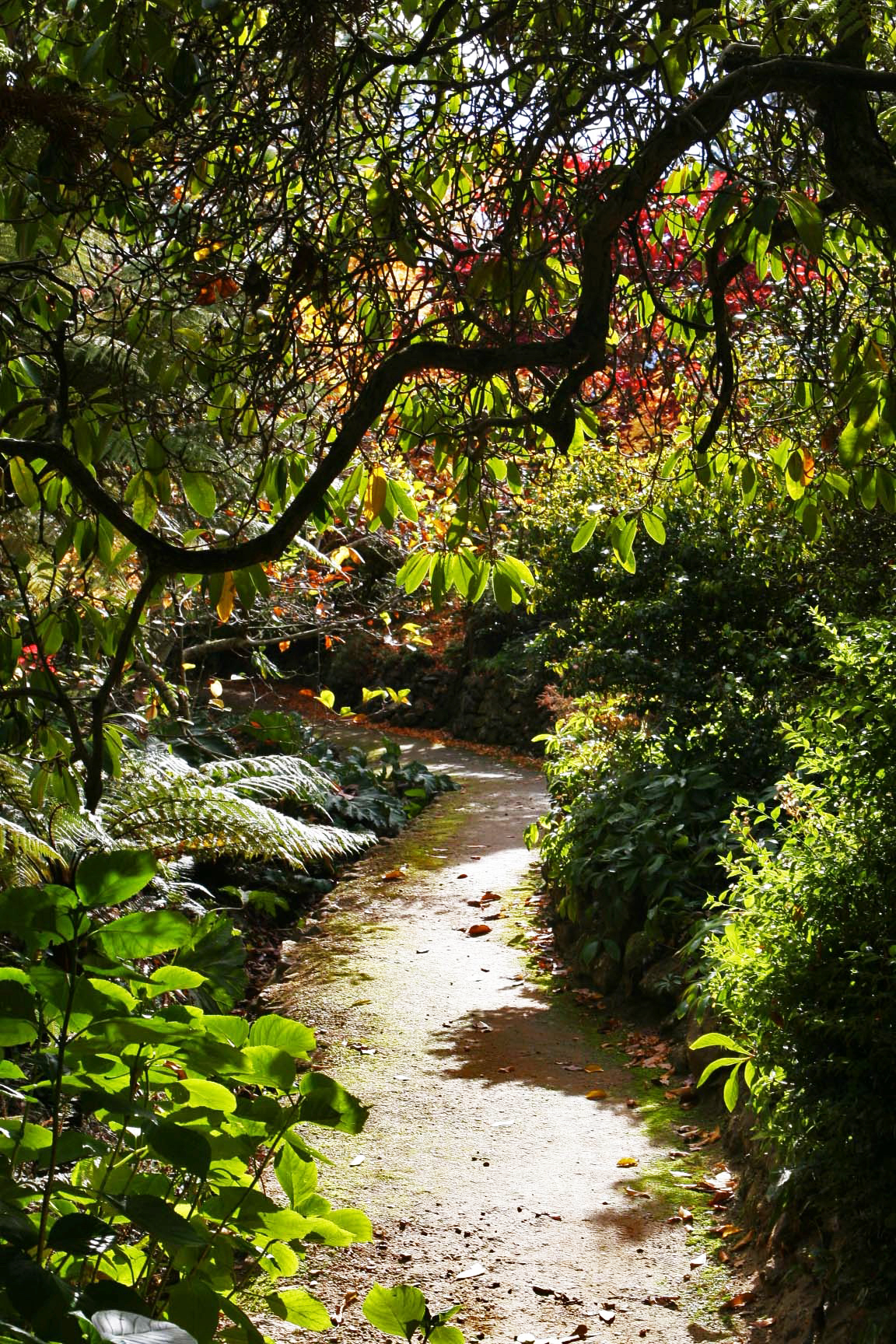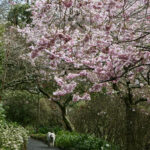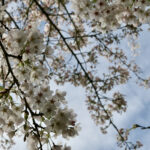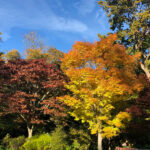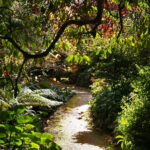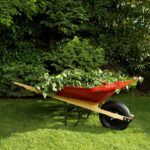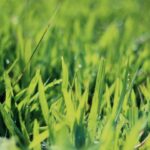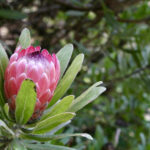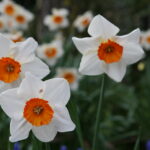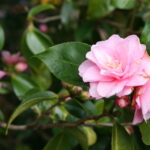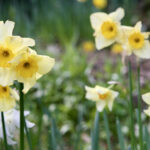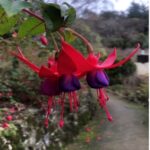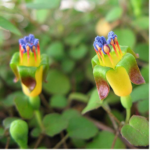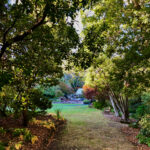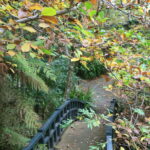Winter 2022
Well the days are definitely short at the moment and the air is damp and cold.
While we think the garden is sleeping and nothing is happening, we couldn’t be more wrong. Things are always going on under the ground, or in the branches, where you can’t see them. Bulbs are a great example of this. They are putting all their stored energy into producing leaves to push up through the surface. These will be visible very soon and give us a reminder that Spring isn’t far off. Coupled with the days getting longer, it’s a great feeling.
Another example of the action going on is the buds on the trees starting to swell. Some of these are leaf buds, and others will turn into flowers. Some trees flower before they get leaves and others are the opposite. One of the most obvious trees to show early bud action are the Magnolias. These beautiful trees are preparing to bring Spring to us with a big show of colour.
We have a huge variety of these in the garden and the white one above the Bridal lawn usually flowers first, in early August. An example of a tree that flowers after it gets its leaves is the Tulip tree, Liriodendron. Its luscious green leaves come in Spring and flowers in December. But all this planning and action by the plant is underway now.
And just to confuse everyone you can currently see the Prunus Autumnalis flowering in the garden. This tree can flower multiple times a year, with or without leaves, and is always a gem when you come across it.
Stay warm and keep positive, Spring is on the way.
Alan.
Autumn 2022
Glenfalloch is known as a Spring garden, and it certainly is beautiful when it’s full of colour with its Magnolias, Rhododendrons and Azaleas flowering. But what we often forget is the color of Autumn. This is when the deciduous trees take over from the fancy flowering varieties of plants. Have you ever wondered why these trees have leaves that change color and drop them?
The majority of these deciduous trees are not native to New Zealand and come from countries that have a much harsher climate to us here. To survive through a constantly freezing winter these trees have learnt to adapt to survive. Once it starts getting colder, and the days shorter the tree senses this and starts the process of drawing the goodness out of the leaves and back into the core of the tree, it’s roots. Chlorophyll is the green pigment that makes the leaves green and this is what helps the trees make energy from the sun. Chlorophyll is one of the first things to be taken out of the leaves for storage, hence the leaves changing color with the other pigments in the leaves now able to be seen. Once the leaves have had the goodness extracted, they are then shut off to the trees system and are free to fall. Different tree varieties do this at different times with some trees being very early to give us Autumn color.
Another reason for trees to lose their leaves for winter is that the trees then have less area for snow to land on ( in the process protect it’s branches from snapping under the weight) and the wind to catch hold of ( once again to stop branches breaking or even the tree blowing over).
Here at Glenfalloch we have a Pin Oak above the Herb garden that is always one of the first to change. It obviously doesn’t want to risk being damaged just for the sake of a few more days of weak Autumn sun. Where as the Oak at the bottom of the Homestead lawn doesn’t mind taking the risk of broken branches for the extra days of sunshine. Or maybe the Oak has just adapted better to the New Zealand climate and realizes that it’s unlikely to get a blizzard here.
You will notice that evergreen trees from the countries where these trees come from have a totally different leave shape and are usually in the form of a needle. This is their way of combating the conditions. Our native trees come with a variety of leaves. A few are deciduous, I’m thinking of the Tree Fuchsia, some have needle leaves think Totara and some glossy evergreen leaves, think of the Karaka. We have a temperate climate in New Zealand and it can change dramatically in a short distance. This is why the poplars in Dunedin just don’t compare with the Autumn color of the poplars in Central Otago.
Have a good Autumn and keep preparing for Winter, just like the trees.
Alan.
Summer 2021/2022
Summer is upon us and we don’t have much time left to enjoy it. I’m a sun lover so I love seeing a clear blue sky with the sun beaming down. We really need to make the most of it in Dunedin and the garden here is situated beautifully to maximise those rays. Although I must admit, as I’m getting older I don’t stay out in the sun quite so long. Handily there’s always an area in the shady part of the garden that needs work so I can just move there if necessary.
It’s shade and ‘feel’ that I’m going to talk about today. On a hot day there is nothing more pleasant than hiding under a leafy green canopy in a garden. Walking around Glenfalloch on a hot day it’s lovely to walk under the Golden Elm that grows over the path that is above the garden behind the Bridal lawn. If you get the right time of day, when the sun is shining through the leaves, it gives a beautiful green hue to the garden.
Gardens tend to have a feel to them and that ‘feel’ can change within a few meters. On a hot day you can feel quite different when you walk from the sun drenched open into the shade of a large tree.
At Glenfalloch there is a real change to the ‘feel’ of the garden as you walk from the lower garden, past the fern garden and up the path. Although it is shadier up this path, I think it is something more than that. The type of planting changes to native species and away from the exotic plantings. There seems to be more Oxygen in the air, you feel calmer, and at ease. You feel at home. I can only think that this is the native plants making you welcome and drawing you in to be part of the universe that they live in. This area of course is overseen by the magnificent Matai which stands guard and watches all that goes on. It is always grounding to stand by this ancient tree, still yourself, listen to the sounds and imagine what has passed before you. It is a great place for reflection.
So please, the next time you come to Glenfalloch, walk a little bit further up the path and get a real ‘feel’ for the place.
Happy Summer, Alan.
Spring 2021
People often talk about Spring colour so I thought that I would too. There’s plenty of it in the garden at present, and it doesn’t last long so best to visit now. Then maybe again the next week, as the garden is always changing with different plants flowering and giving the garden a different feel.
Spring to many people is flowers of bright colours, and often conjures up childhood memories. To me there are 2 main colours that come to mind with Spring.
The first one is the yellow of the daffodils. Who can ignore their beauty as they emerge from the ground and put on a stunning show of perfection. Just the sight of them breaking up through the soil late in winter gives me comfort in knowing that spring isn’t far away.
The second colour could be red, pink, or purple but no, my favourite colour of spring is green. Spring green is like no other and it is the lushness of the new growth that gives me the feeling of life and vitality. It’s no wonder that leafy green vegetablse are so good for us.
As I’m writing this, I look out into the garden and see the Oaks breaking into leaf and the daffodils flowering underneath. What a sight to see. Welcome Spring, come and revitalise us all!
Happy Spring, Alan.
Winter 2021
For some people gardening is like punishment, for others it is time out of their busy world and find it quite relaxing. Often these feelings come from childhood experiences. The house I grew up in had a long gravel driveway, and as a youngster I can remember having to go out and weed the driveway. Each sibling had to do 30 minutes. I can assure you there was some clock watching going on! This obviously didn’t harm me.
I grew seedlings from the Kakabeak that grew outside my bedroom window and can remember bringing home a beautiful white flowering bulb for my mother. Years later I realised that the bulb I planted in the garden with the beautiful white flower was Onion weed. It took years to get rid of them.
We each have our ideas of what gardens and garden tasks should look like. Because of that, gardens are subjective, very much like a piece of art. The difference here is that almost everyone has this ‘art’ on display to anyone that visits or passes their house. Because of this we like it to look good. Plant selection is always very important.
To me some plants are more valuable than others. In a time poor world there are some brilliant plants that once planted take very little time to look after and give so much in return.
One of these plants is the Fuchsia. There are many different varieties available and come in colours of white through to dark pinks and purples. We have our native varieties of which the kotukutuku, or tree fuchsia, is the largest variety in the world.
We can also claim the smallest variety in Fuchsia procumbens, which is a prostrate shrub that creeps across the ground.
Both we have in the garden at Glenfalloch. And they have some interesting features which I can talk about another day. But the best value fuchsias are the showy ones that flower for months on end with very little attention. They come in a variety of shapes, sizes and colours.
All we do with these is cut them back hard in winter (and they still have flowers on them) and by the time summer is here we have flowers again. We very occasionally give them some water if it’s been a dry summer.
So they really are the best plants out there for months of colour with very minimum care and attention.
Stay warm, Alan
Autumn 2021
Once again autumn is upon us with the nights getting longer and days shorter. It’s time to appreciate the good days and snuggle down at home on the not so good days.
I’m here to talk about the good days, days where you want to get outside for some fresh air. Days where you can take in the beauty of the changing season.
When you are outside next, take a moment to notice the changes. Look for the leaves changing colour, the different colours of those leaves, how those leaves show you the sheltered spots in the garden. Notice the flower buds on the Camelias and Rhododendrons starting to form, a reminder that Spring and its abundance of flowers has started its gradual build up. Think how pleased the plants are to get some moisture, remember that last hot day when you had not drunk enough. Plants cannot take themselves off for a drink, they must wait for nature or an observant human that notices the signs that it is struggling.
A struggling deciduous plant will often drop its leaves early if under stress from dryness. This is the plants way of reducing water loss and increasing its chances of survival. A heavily stressed plant may have one last push to flower prolifically and seed, to at least keep the species going, then collapse never to flower again.
Plants have a wonderful way of showing us how to survive.
Put your roots down deep, take the good with the bad ( there is always some bad that we just can’t do anything about, just like the dry plant), drop things when you’re stressed, live in the moment and know that if times are tough, time to blossom is just around the corner.
Enjoy your garden or come and enjoy ours.
Happy Autumn, Alan

